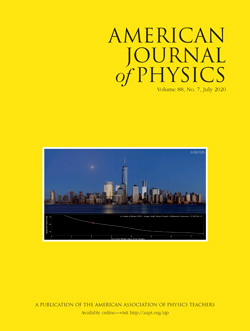 July 2020 Issue,
July 2020 Issue,
Volume 88, No. 7
Volume 88, Issue 7, July 2020
How would a nearby kilonova look on camera?
Kilonovae are cosmic optical flashes produced in the aftermath of the merger of two neutron stars. While the typical radiant flux of a kilonova can be as high as 1034 W, they typically occur at cosmological distances, requiring meter-class or larger telescopes for their observation. Here, we explore how a kilonova would look like from the Earth if it occurred in the Solar System's backyard, 1000 light years from the Earth. This is a small distance on cosmological scales, with only one neutron-star merger expected to occur this close every 100 000 000 years. While humans will likely only see kilonovae at much greater distances, showing how such a nearby event would look on camera can help visualize these events and demonstrate their unique spectral evolution.
EDITORIAL
Editorial: Blurbs, round III by Richard Price. DOI: 10.1119/10.0001432
GUEST EDITORIAL
Post-pandemic science and education byRoger D. Blandford. DOI: 10.1119/10.0001390
PAPERS
Slow sound: An undergraduate lab experience for critical thinking by David L. Sidebottom. DOI: 10.1119/10.0001023
Teaching the electrical origins of the electrocardiogram: An introductory physics laboratory for life science students by Catherine Hirshfeld Crouch and John W. Hirshfeld Jr. DOI: 10.1119/10.0001039
Computer-based learning in an undergraduate physics course: Interfacing a mobile phone and matlab to study oscillatory motion by Ernesto Momox and Charby Ortega De Maio. DOI: 10.1119/10.0000961
Can students apply the concept of “which-path” information learned in the context of Mach–Zehnder interferometer to the double-slit experiment? by Alexandru Maries, Ryan Sayer and Chandralekha Singh. DOI: 10.1119/10.0001357
Lorentz contraction during acceleration from one inertial frame to another by Ashok K. Singal. DOI: 10.1119/10.0000964
Bell, Bohm, and qubit: EPR remixed by William H. Press. DOI: 10.1119/10.0001189
A powerful graphical display of technical information: Robert Serber's plot of physical conditions inside a nuclear explosion by B. Cameron Reed. DOI: 10.1119/10.0001206
How would a nearby kilonova look on camera? by Nihar Gupte and Imre Bartos. DOI: 10.1119/10.0001193
Simulation study of nuclear shell model using sine basis by Aditi Sharma, Swapna Gora, Jithin Bhagavathi and O. S. K. S Sastri. DOI: 10.1119/10.0001041
INSTRUCTIONAL LABORATORIES AND DEMONSTRATIONS
An autocollimator with sub-microradian sensitivity by N. Pelle, L. Ehinger, C. R. Zaug and W. J. Kim. DOI: 10.1119/10.0001269
BOOKS RECEIVED
American Journal of Physics 88, 592 (2020); https://doi.org/10.1119/10.0001347
About AJP
General Information, Resources for Authors, Reviewers, and Readers

